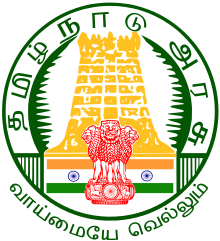Gudiyatham
Gudiyatham (also called Gudiyattam or Gudiyettram) is a Sub District and a historical town of Vellore district. It is a municipality in Vellore district in the state of Tamil Nadu in India. It is the most populated town in Vellore District before and after the separation of Tirupattur and Ranipet Districts. It lies between Bangalore and Chennai. District headquarters Vellore is 31 km away from the town. In 2011, the town had a population of 235,672. This is where the first Indian national flag was woven. Gudiyatham is a first-grade municipality. It was named Gudiyatham Municipality in 1886. The town is a match-box manufacturing and hand-looming centre. The occupation of the ancient town is artistic handloom weaving. The town is divided into four regions i.e., Gudiyatham East, Dakshina Patha Palem, west and south.
Gudiyatham | |
|---|---|
Urban Headquarters | |
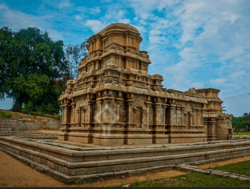 Erukampattu sri ranganathar temple | |
| Nickname(s): Garden city[1] | |
 Gudiyatham Location in Tamil Nadu, India | |
| Coordinates: 12.93972°N 78.8644°E | |
| Country | |
| State | Tamil Nadu |
| District | Vellore |
| Founded by | Kulothunga Cholan |
| Government | |
| • Type | First Grade Municipality (Sub District) |
| • Body | Gudiyattam Municipality |
| Area | |
| • Total | 30.08 km2 (11.61 sq mi) |
| Elevation | 270 m (890 ft) |
| Population (2011) | |
| • Total | 235,000 |
| • Density | 7,800/km2 (20,000/sq mi) |
| Languages =Tamil, Telugu, Urdu | |
| • Official | Tamil, English |
| Time zone | UTC+5:30 (IST) |
| Postal code | 632601,632602,632603,632604,635 803,635806,635805,635813. |
| Telephone codes | +91 ,04171 |
| Vehicle registration | TN 23 |
The town was built by Kulothunga Cholan during his reign. He named it as "Kudiyetra-nallur" which denotes a place suitable for good living.
Etymology
Kulothunga Chola named the town "Jayamkonda Sathurvethi Mangalam".[2] This was followed by rapid settlement of the town, so the town was renamed "Kudiyattrem", which metamorphosed into "Gudiyattam", to commemorate the influx. According to a myth, Karikala Cholan first cleared forest and then had people settle here, so it was named "Kudiyetram", which evolved into "Gudi-yetram". The supportive evidence for the myth is that the town is populated with one community who were of Chola kingdom. An inscription of 14th century found at Chenji (now in Cuddalore District) also reveals existence of the town in the name of “Gudi-yetram”. The passage of time and most probably British tongues changed the name to "Gudiyatham".
History
The city was formerly created by Kulothunga Chola by extending lands. He named it "Jayamkonda Sathurvethi Mangalam". After a few years, many people settled in the town. Archeological excavation shows that the town flourished during Chola rule. Many Roman wine vases and coins were found in the town's periphery.

The town's existence is mentioned in the ancient inscription of Kulothunga Cholan's first regime in 1705 A.D. The town is surrounded by a good number of temples. The temple of Kappuleeswarar existed during the period of the Kulothunkkan 1st dynasty. During the regime, the king had denoted 90 ghots for maintenance and for purchase of oil for lighting. These inscriptions are found in the Kappuleeswarar temple Nandi Veeda inscription. The ancient temple was built at Nallore (Alias) Jayamkonda Sadurvedi Mangalam. The town was donated by the king, Kulothungan, following the victory in the Thondai Mandalam regions. The temple has been further modified and renovated by the Vijayanakara kings. The temple is a symbol of monuments of both Chola and Vijayanakara kingdoms.
The area around the Kappuleeswarar temple in ancient Nallore is now named Nellorepettai.
Sri Lakshmaiyah Chetty[3] was a pioneer in developing the town who established a cloth store in 1850 which mainly sold handloom products such as sarees and lungis. He also encouraged people to weave handloom products and he was the first to export handloom items to northern India and was the first to import Kasi sarees.
Geography
Gudiyatham is the largest municipality town in Vellore district, Gudiyatham is about[4] 160 km west of Chennai and 165 km southeast of Bengaluru. The town is near the border of Andhra Pradesh state. Gudiyatham is surrounded by over 500 villages. Gudiyattam is around 30.0 kilometres from its district headquarters Vellore. The following are the surrounding districts:
| Chittoor district | 38.9 km. |
| Kolar district | 97 km. |
| Kanchipuram district | 91.7 km. |
| Tiruvannamalai district | 91.8 km. |
Rivers
The Gowndanya Mahanadhi is a seasonal river which flows through the city's centre. Being a tributary of the river Palar, it also receives water and rejoins the Palar at Pallikonda. Mordhana dam and Rajathoppu check post were dams built across the river.
Demographics
According to the 2011 census, Gudiyatham had a population of 235,672 with a sex-ratio of 1,029 females for every 1,000 males, much above the national average of 929.[5] A total of 9,273 were under the age of six, constituting 4,738 males and 4,535 females. Scheduled Castes and Scheduled Tribes accounted for 16.8% and 0.1% of the population, respectively.
The average literacy of the town was 77.46%, compared to the national average of 72.99%.[5] The town had 55,103 households. There were 1,05,133 workers, comprising 9,700 cultivators, 25,373 main agricultural labourers, 6,501 in household industries, 40,891 other workers, 22,668 marginal workers, 877 marginal cultivators, 8,949 marginal agricultural labourers, 1,122 marginal workers in household industries and 11,369 other marginal workers.[6]
As per the religious census of 2011, Gudiyatham had 81.58% Hindus, 16.96% Muslims, 0.98% Christians, 0.01% Sikhs, 0.01% Buddhists, 0.28% Jains, 0.16% following other religions and 0.02% following no religion or did not indicate any religious preference.[7]
Tourism
The paintings of Pallava period are visible in the hills near Melmalaiyampattu village. The paintings of Jain statues were seen on the top of the naturally found cave structures. These artifacts were destroyed over a period of time and only their remains are there now. Dr. Nagasamy gives a detailed view of those monumental paintings in his “Oviya Paavai”. Yet the remains of the paintings of the 7th and 8th centuries alone can now be seen. The restored edifice of the Jain construction would be viewed right under the cave paintings. A few Paleolithic monuments are found nearby along with black and red pots and tiles in the nearby ash mound. The paintings portray scenes of a Jallikattu clash, a warrior fighting a leopard and a man riding a bullock cart. Archaeologists confirmed that the paintings were more than 5000 years old.[8]

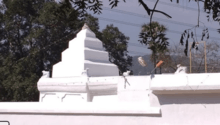
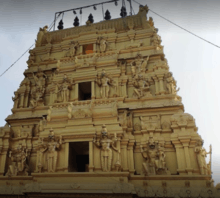
Mordhana dam[9] is about 25 kilometers from Gudiyatham and is built across the Gowndanya Mahanadhi river. The dam was built between two hills covered with lush greenery and is 33 meters high and 220 meters long and is protected by the forest department of the Tamil Nadu government.
Koundinya Wildlife Sanctuary [10]is just 26 km from Gudiyatham. Kaundinya Wildlife Sanctuary is a wildlife sanctuary and an elephant reserve situated in Andhra Pradesh, India. It is the only sanctuary in Andhra Pradesh with a population of Asian elephants, which migrated after 200 years from neighbouring regions.
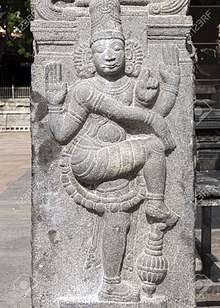
Karupuleeswarar Temple complex'[11], also known as Balasarthuleeswarar (Baby-Tiger Eswarar) temple in Nellorepet is more than 1000 years old and is historically connected with Gudiyatham town. It is famous for its car festival Thaer Thiruvizha. This temple was the abode of the sage Goundanya Rishi and the river passing through the town, "Goundanya Maha Nadi", is named after him. The temple has a lion tank (Simha Kulam).

Gangaiamman Temple complex[12] in Gudiyatham is famous for its annual four-day carnival (Gangai Amman Thiruvizha) during 14–17 May (Tamil month - Vaigasi 1st) which attracts 10 lakhs of people. For the occasion, the government announces a local holiday for the whole district. In January 2018, a linga was founded by the temple administration and named "Gangaeeswara".
Shree Balaji temple complex Meenur is nearly 10 kilometres from Gudiyatham.
Shree Then Thirupathi Perumal Kovil is in Pichanoorpet.
Navagraha temples[13][14][15][16][17][18] The Navagraha temples listed contain separate shrines for these gods or temple deity worshipped as that god.
- Surya Navagrahastalam - Karupulleshwarar temple, Nellore, Gudiyatham
- Chandra Navagrahastalam - Sri Linganatha Swamy temple
- Angaarakan Navagrahastalam - Sri Mahadevar temple
- Budha Navagrahastalam - Sri Semmalai temple
- Guru Navagrahastalam - Sri Gurubhagavan temple, Perumbadi.
- Sukra Navagrahastalam - Sri Kaalabhairavar temple, Pogalur
- Shani Navagrahastalam - Sri Baalasarthuleshwarar temple, Gudiyatham north
- Raahu Navagrahastalam - Sri Naganathaswamy temple, near Gudiyatham
- Ketu Navagrahastalam - Sri Naganathaswamy temple, near Gudiyatham
Veera Vijaya Anjaneya Swamy Temple is one of the oldest temples and dates to 1900. The monument was carved on stone near a small hill near the village. The local people visit the temple annually during Kartika Purnima to perform poojas and abhisheka to the Lord Hanumanji. Then, the people of D.P. Palayam renovated the temple for Hanumanji requiring nine or ten years. On 1 July 2011 the Chaitra Purnima Kumbhaabhishekam for this temple is performed. Thousands of devotees and Swami Kanchi Jayendra Saraswathi from Kanchipuram and Durga Prasad Swamiji from Vijayawada or Bejawada joined this auspicious function. Devotees can also take up a Vrata Deeksha called Anjaneya Malaadhaarana for a period of 40 days and perform the rituals at the end either at the Hanuman Temple in the village or at Vijaywada. Every full-moon day, and on Hanuman Jayanti, people celebrate the occasion in an auspicious manner. Many people visit the temple each month.
Arulmigu Subramaniyar temple in Kamatchiamman Pet, was built decades ago and is famous for its 'Sura-Samharam' event conducted annually in the Tamil month of 'aipasi'. This temple is administered by a local community's trust body.
Kaala Bhairavar temple[19] is 3000 years old and is in Pogalur, which is 7.5 km away from town. Siva-Siva temple is on Vani Street and was built centuries ago and is famous for its monthly Pradhosham events.
Arulmigu Punganoor Amman Temple is behind the old bus stand in Chunnambupet.
Sethukkarai Shri Swayambu Vinayagar temple complex[20] is near Sedukkarai hill town. Vinayaka is the presiding deity of the temple. According to the legend, the deity is Svayambhu (self-manifested) and is one of the greatest Vinayagar temples in the world. It is currently known for the Girivalam (circling the hill) by the locals on full-moon days.
Errukampattu Sri Ranganathaswamy temple[21] was built in the late 9th or early 10th century and is attributed to the god Vishnu consecrated Ranganatha Temple. The temple, which is surrounded by a wall with an imposing portal, differs from most Chola temples in the region by its almost geometric, but restored, gate and tower decor; it consists of a mandapa (a flat, covered porch) and a vimana (a stepped tower structure) with a transverse bearing. While the outer walls - apart from their pilasters - and niche structure are almost unadorned, there are numerous blind windows on the cornice fronts (kudus).[22]
Cuisine
Gudiyattam's signature dishes include palkova, sweet somosa, and vegetarian and non-vegetarian dum dum biryani. The cuisine was introduced by the Nawabs of Arcot who once ruled the area.[43]
The Ambur/Vaniyambadi biryani is accompanied with 'dhalcha,' a sour brinjal curry and pachadi' or raitha, which is sliced onions mixed with plain curd, tomato, chilies and salt. It has a distinctive aroma and is considered light on the stomach. The usage of spice is moderate and curd is used as a gravy base. It also has a higher ratio of meat to rice.
Palkova is a dairy sweet which is enriched with pure, thick milk without any added water. The only added sweetener is sugar. It is an eggless milk recipe. The palkova is also known as Milk Peda.
Transportation
The nearest railway stations are in Gudiyatham and Ambur. The nearest railway junctions are in Vellore [Katpadi] Junction, Chittore junction (AP State). The nearest airports are in Vellore, Bengaluru and Chennai. The nearest seaport is Chennai.
Roads
In 2010, the opening of NH 234 highway was announced. NH234 passes through town on the way from Mangaluru to Villupuram en route to Vellore and Tiruvannamalai.[23] The nearest highway junction is in Pallikonda.
Commerce
India's second telephone network was installed in Gudiyattam after B. Rajagopal Naidu M.L.A. made a request to Prime Minister Rajeev Gandhi who was visiting for the opening ceremony of Rajagopal Polytechnic College.
India's first national flag hoisted after Independence was woven in Gudiyattam. This flag was hoisted by the first prime minister Pandit Jawaharlal Nehru at Redfort on 15 August 1947. In appreciation, the national leaders viz., Motilal Nehru and Sardar Vallabai Patel in their letter dated 12.08.1947 complimented the weavers.
Gudiyatham has small-scale manufacturing of safety matches, lungis, and beedis. The safety matches industry is the second-largest in Tamil Nadu after Sivakasi. Gudiyatham is nicknamed "The Little Sivakasi" because of its match-box factories. Beedis are exported to Pakistan and other parts of India. The handloom and powerloom lungies manufactured here are sold in India, Africa and Arab countries. The entire Middle East is supplied with handloom lungis by exporting firms in Gudiyatham. The major occupation of the nearby villages is agriculture. Sugar cane, paddy (unmilled rice) and other vegetables are cultivated here and transported to the nearby markets called Ulavar Santhai in Tamil in Gudiyattam.[2]
Cattle and milk production are also important and most villagers are active in both agriculture and cattle-farming. For over a century, a cow and ox market has been held near Nellorepet every Tuesday.
The town has more than ten cinemas. Six of the theatres are near the Kamarajar bridge. Other theatres, Murugan and Raguram, are also in town. Gudiyatham is famous for producing golden jewellery. There are more than 400 jewellery shops in the town. Being on the Katpadi-Jolarpettai railway line, it is well connected to Chennai and Bengaluru. A cow and ox market has been held near Nellorepet every Tuesday for over a century.
Education
- Gudiyattam Polytechnic College was established in 2008. It offers diploma courses in Mechanical, Civil, Electrical & Electronics, Electronics & Communication and Computer Science Engineering.
- The Govt. Thirumagal Mills college, Gudiyatham was established in 1964–65. The college was established with a pre-university course and it now has six UG courses and two PG courses apart from two certificate courses. It is on the Gudiyattam-Katpadi Road.
- The K.M.G College was founded in 2000. It originally had seven undergraduate courses, but now offers ten undergraduate courses, six PG courses and two research programs.
- The Rajagopal Polytechnic College was established in 1960. It offers three-year diploma courses in Civil, Mechanical, Electrical, and Electronics, Electronics & Communication Engineering, and Automobile Engineering. It is on the Gudiyattam-Katpadi Road.
Politics
The Gudiyatham assembly constituency is part of Vellore Lok Sabha constituency.[24] Kamarajar was elected as a Member of Legislative Assembly from the Gudiyatham constituency when he was the Chief Minister of Tamil Nadu.
References
- named by Professor Dr Karruppanan
- confirmed by inscriptions found in Chenji fort
- murasu article from a news paper in Gudiyatham, Vellore district
- http://cgwb.gov.in/AR/AR-PLans/Tamil%20Nadu/Vellore%20district%201%20Gudiatham_East.pdf
- "Census Info 2011 Final population totals". Office of The Registrar General and Census Commissioner, Ministry of Home Affairs, Government of India. 2013. Retrieved 26 January 2014.
- "Census Info 2011 Final population totals - Gudiyatham(05712)". Office of The Registrar General and Census Commissioner, Ministry of Home Affairs, Government of India. 2013. Retrieved 26 January 2014.
- "Population By Religious Community - Tamil Nadu" (XLS). Office of The Registrar General and Census Commissioner, Ministry of Home Affairs, Government of India. 2011. Retrieved 13 September 2015.
- https://www.dtnext.in/News/TamilNadu/2019/06/23013733/1153211/Save-5000yearold-rock-paintings-near-Gudiyattam.vpf
- http://wikimapia.org/11054031/Mordhana-Dam-Reservoir
- Times of India latest magazine
- refer www.gudiyathaminfo.com
- Dhinamalar, newspaper dated 12-2-2019
- Nagara Valarchi Malar (Tamil), Malai Murasu Press, Vellore, 1993
- Gnana Malar (Tamil), Ambur, Hindu Bharatiya Educational Trust, 1988
- Interview with S. Sendhuran, Executive Officer, Annual Reports on Indian Epigraphy 1887-1907, New Delhi, 1986
- Hultzsch, Epigraphica Indica and Records of the Archaeological Survey of India, Vol. IV, Calcutta, 1899
- The Hindu, Madras, 15 June 1995
- Interview with Agaramoorthy, Archakar of Sri Naganadhasamy Temple, Ambur, on 15 December 1995
- Pogalur village Ramesh Guptha speech on Kalabhairava
- article on temples in Gudiyatham by Dr Sundaramoorthy
- Times of India article on Gudiyatham dated 20 May 2018
- https://www.flickr.com/photos/naadodi/16479165538
- (NH-234 announcement.)
- "List of Parliamentary and Assembly Constituencies" (PDF). Tamil Nadu. Election Commission of India. Archived from the original (PDF) on 31 October 2008. Retrieved 8 October 2008.
https://vellore.nic.in/public-utility/gudiyatham-municipality/ https://www.india.gov.in/official-website-gudiyatham-municipality-tamil-nadu http://www.tamilnadutourism.org/ https://vellore.nic.in/places-of-interest/
